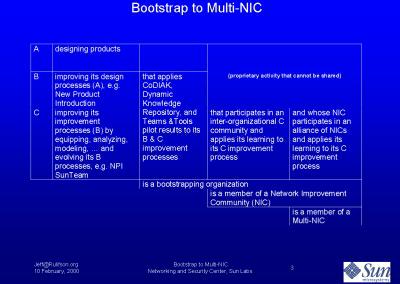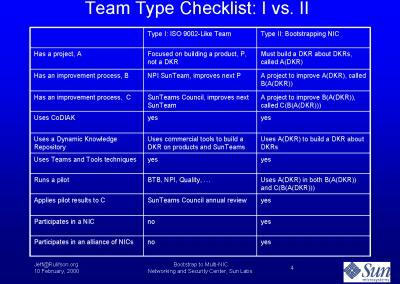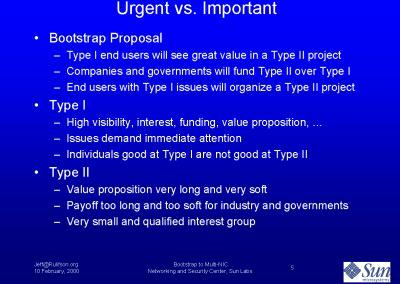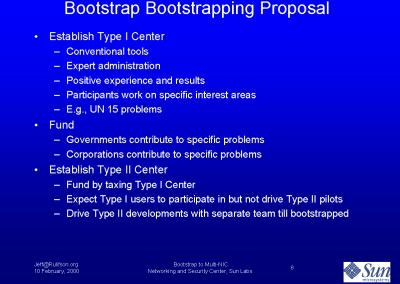Bootstrap to Multi-NIC: A bootstrap bootstrapping proposal Jeff Rulifson. 1.* - unedited transcript - So I am going to go on a suicide mission. A couple of years ago, I took Doug, and we went to Japan and tried to explain bootstrapping to the Japanese, very interesting experience. They actually got a lot of it. It is a quality country, so they understand quality circles, and feedback charts and stuff like this. We had a really difficult time. We put up the A, B, and C charts and went though things like this. We did a number of visits, a half dozen or so to various universities and companies. It didn't work too well. They see things right, they have a community, and they use networks so they must be a NIC. But we had a real hard time on trying to zero in on what bootstrapping really is, and when do you really become a NIC, and what the difference between working on a problem and being a bootstrapping organization is. So we went back for a second trips and I made up a small pitch. How to explain, bootstrapping and NICS in two slides?
So we need example, so inside SUNN we build products, and part of the product process there is a piece of it known as the New Product Introduction Process. Where engineering transfers a product to manufacturing. This might involve over a thousand people for a large system that goes out. It is quite an elaborate process, huge manuals for this process. Every few years this process atrophies and they have to start a team to change the process because the process gets out of whack. During this process you have all this stuff that is going on. That is the process that we are going to worry about here. In building this process there are all of these things that we do. This is the A column. We do testing, we write documents, we build stuff, and we train people. There is a whole group of A level activity. In some place there has to be B level activities. Its a B level activity goes on as lots of things. One-way is we constantly upgrade the hardware and software test harnesses as a B style improvement to improve the A activity. We are constantly upgrading the way we handle the engineering change order database. This database for giant products over the cycle of the whole thing might have tens of thousands of engineering change orders. It's a huge complicated thing. Upgrading that, it is improving at the way the data base works is improving at a B level the way we do the A level. Another thing we do at the B level is the NPI SUNN teams every couple of years. What they do is go in and change all this stuff that is going on, plus look at the way all of this works. They are an official B level team that is improving things. Inside SUNN there is another level of activity going on. The NPI SUNN team is just one improvement team that goes on. There are actually a lot of improvement teams inside SUNN. They are going out and improving these various processes that is going on. There is one overall sun team. They are run by the quality office. Their job is actually to go out and make sure that these various specific SUNN teams actually get their jobs done. They hold training classes, they monitor their progress, give awards; they actually give stock bonuses and all this stuff so that they are successful. That is a clear C team in that it is improving the way we improve the things that we do. We are being clear about the A, B, and C. When we get to bootstrapping, and what's a NIC, and how to get the Niches going, we have to be clear and crisp about where is your A stuff B stuff and C stuff.
So here is the explanation with a different form. We design products. That is our A level activity. The B level activity is improving the design process in some way. We are improving the product introduction process. At the C level we have the overall SUNN team improving the B level things. Inside SUNN this is all very networked and there are kinds of tools. It doesn't make it a NIC or a bootstrapping organization at all. There is a clear distinction about what is going on here. What the bootstrapping organization has to do is being focused not on how to make some products or how to teach kids at schools. There has to be focus on CO-diak and dynamic knowledge depositories. The activity that is going on here has to be focused on this stuff. You have to be running a pilot about the nature of dynamic knowledge depository stuff. How one builds or improves them. If that is your project, and you have pilots going on, then you are becoming a bootstrapping origination. Just because you have all this activity going on about new product improvement, doesn't really qualify. You have to be focused on bootstrapping on this fundamental bootstrapping cycle, which is the problem with building these dynamic knowledge depositories, not the problem with education or how to build things. Now you can get bootstrapping organizations and they participate more than one of them together, then they are a NIC TM bootstrap, rather than a NIC in the world at large. There is a distinction going on here. Then if there are a whole bunch of things going then you can build them into a MetaNIC. So if we can get that far, where we want to get to with all of the bootstrapping, is to projects focused on these CO-diak DKR tools and teams subject areas. Then get them going and build them into a NIC. The NIC being the conglomerate of all of the individual projects we have been at that for a long time. Doug has been trying to get these going and it is not happening in a lot of ways. What has happened? Why don't people automatically do this? Let's try to understand what happened here.
This is a list off the previous chart. You have to have a project, you have to have an improvement process, and you have to have an improvement process for the improvement process. You have to be using the CO-diak things and using a knowledge depository, and be doing all of these things. What is the different between the NPI and a bootstrapping NIC, the topic area? In our NPI NIC, we are focused on building a product not a dynamic knowledge depository. If we had a real bootstrapping project, the project would be focused on building the dynamic knowledge depository. We have a NPI SUNN team that is focusing on improving the product, where is if we had a real bootstrapping the improvement process would be focused on improving the use of the dynamic knowledge depository, not making the product better. The SUNN team counsel that is improving all the SUNN teams inside SUNN. Working for SUNN's business, but that is not what the bootstrapping MetaNIC would be doing. The bootstrapping C level stuff would be focusing on multiple versions of the improvement process of the dynamic depository. This goes on.
In a sense the bootstrap value proposition is that we have this type one end users, with business or educational problems. They would see enormous value in a type two project. We have companies and government would see so much value in the type two projects that they would fund them. That the end users with the type one issues would take a lead in driving the type two projects. But this is not happening. I think if I look at the interest and what has been going on over the last few years, it really becomes clear to me. The type one projects have high visibility, high interest, and lots of funding behind them. The urgent vs. important sense, they are all urgent. Lots of money riding on them and lots of focus. The individual who are good at doing the type one-style projects are really good at doing the type two projects. The type two-value proposition is very long, way out over the horizon. Often if you go and talk even to the government funding agencies the pay off is so far over the horizon that they don't want to deal with it. The actual people who are interested in how one improvements dynamic knowledge depositories is a very small group of people compared to a type one group. What I want to see us do is this is one..... This is what I propose to break out of the cycle of always getting a lot of type one projects going but never being able to leap into the bootstrapping NIC kind of project.
So take the UN fifteen problems that Doug talked about in the first slide. Establish a type one center, to work at the fifteen slides. Do it a SRI because you have all of the expertise about how to build the type one center. You have all of the tools available, and if you don't then SUNN and IBM will give you the tools. You have expert administration, you really know get positive results, know how to advise people, and make it click. We could go out on UN stuff and go to industry and get funding for it. Go to Exxon and go to counties and get the money for it. Specifically tax those projects to take a percentage of money off them to do the type two projects. I don't think that we will every get the type one projects on their own to do the work. End of my time.
---
Above space serves to put hyperlinked
targets at the top of the window
|

 Fig. 1
Fig. 1 Fig. 2
Fig. 2 Fig. 3
Fig. 3 Fig. 4
Fig. 4 Fig. 5
Fig. 5